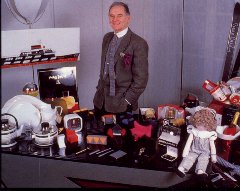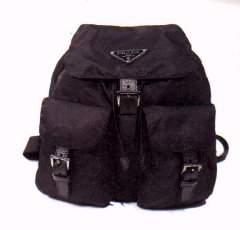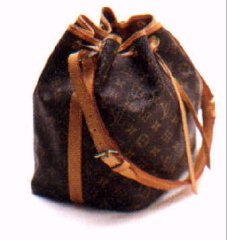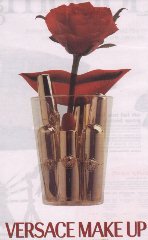
Return to 1997 AUTUMN Index
![]()
by Anita Hunter
 We haven't even got to the end of the decade and the concept of
the 'caring, sharing nineties' seems to have run out of steam. A
few windfall shares and the optimism created by a new
Government have catapaulted us back into the rampant 'Greed is
Good' materialism of the eighties. Conspicuous consumption is
back with a vengeance and no more obviously so than in the cult
of the label.
We haven't even got to the end of the decade and the concept of
the 'caring, sharing nineties' seems to have run out of steam. A
few windfall shares and the optimism created by a new
Government have catapaulted us back into the rampant 'Greed is
Good' materialism of the eighties. Conspicuous consumption is
back with a vengeance and no more obviously so than in the cult
of the label.
Desirability rather than necessity have always driven fashion and the current cult for branded merchandise reflects that a designer's name may be just as marketable as his or her Collection. Desirability can be instilled into quite ordinary and unexceptional products once a brand or 'marque' has been established. T-shirts, jeans, perfume and sunglasses can all become 'must-have' items (with the appropriate price tag) by the addition of a Designer name or logo.
Coco Chanel was the first to license her name for the perfume No 5. But it was in 1948 that Christian Dior signed the first 'licensing deal' in fashion history. Dior was one of the first designers to realise the potential that lay in the commercial exploitation of a couture name. The innovative 'New Look' of 1947 and subsequent collections established Dior as the most important and prestigeous fashion house in the world. By the 1950's, the name had become synonymous with quality and the company was able to exploit this by setting up a perfume company and negotiating licence and merchandising agreements.
 Pierre Cardin, "the man who became a label", worked for
Dior on the inaugural 1947 collection. A great technician
and innovative avant-garde designer, he was one of the first
to recognise the power of the press and had an intuitive
understanding of P.R. Cash flow difficulties in the late
1950's forced him to explore licensing. The benefits were
huge - an immediate injection of cash, royalties and none of
the huge costs of manufacturing. In 1959 Cardin was the
first couturier to sign a licensing deal for off the rack
dresses. "Everyone was copying my clothes so why
shouldn't I do the ready-to-wear." Menswear and a Cardin
perfume quickly followed. Although his fashion star was declining by the late 1960's, the licensing went
from strength to strength. Cardin found that his name could sell pretty much anything from chocolate to
carpets. "If I dress a man, why shouldn't I dress everything around a man, his surroundings." By the
mid-1970's, too many licenses meant that he was loosing control of quality and a coherent brand
image. Although he retained the right of approval on all products, it was impossible to police. By the
1980's the label had lost it's cachet but the Cardin name still had (and still has) an enviable recognition
factor. Merchandising and licensing may have overshadowed Cardin's reputation as a designer but
they have made him one of the world's richest men.
Pierre Cardin, "the man who became a label", worked for
Dior on the inaugural 1947 collection. A great technician
and innovative avant-garde designer, he was one of the first
to recognise the power of the press and had an intuitive
understanding of P.R. Cash flow difficulties in the late
1950's forced him to explore licensing. The benefits were
huge - an immediate injection of cash, royalties and none of
the huge costs of manufacturing. In 1959 Cardin was the
first couturier to sign a licensing deal for off the rack
dresses. "Everyone was copying my clothes so why
shouldn't I do the ready-to-wear." Menswear and a Cardin
perfume quickly followed. Although his fashion star was declining by the late 1960's, the licensing went
from strength to strength. Cardin found that his name could sell pretty much anything from chocolate to
carpets. "If I dress a man, why shouldn't I dress everything around a man, his surroundings." By the
mid-1970's, too many licenses meant that he was loosing control of quality and a coherent brand
image. Although he retained the right of approval on all products, it was impossible to police. By the
1980's the label had lost it's cachet but the Cardin name still had (and still has) an enviable recognition
factor. Merchandising and licensing may have overshadowed Cardin's reputation as a designer but
they have made him one of the world's richest men.
 Christian Dior advised Cardin "don't sell at a low price.
Make it expensive. Talent should be paid for". Where
profits are the name of the game, the price has to be right
and ultimately, Cardin diluted the overall value of his name
through uncontrolled licensing and high street prices. Other
designers have found many benefits in keeping their
merchandise expensive, elusive and prestigeous. The black
nylon Prada bag illustrates that a huge price tag can actually
contribute to the overall success of a line. Practical, but
ludicrously expensive, a discreet tin triangle screamed out to
the cognoscenti that this was no ordinary black shopping
bag but a stylish Miuccia Prada accessory. Thy sold and
sold and sold.
Christian Dior advised Cardin "don't sell at a low price.
Make it expensive. Talent should be paid for". Where
profits are the name of the game, the price has to be right
and ultimately, Cardin diluted the overall value of his name
through uncontrolled licensing and high street prices. Other
designers have found many benefits in keeping their
merchandise expensive, elusive and prestigeous. The black
nylon Prada bag illustrates that a huge price tag can actually
contribute to the overall success of a line. Practical, but
ludicrously expensive, a discreet tin triangle screamed out to
the cognoscenti that this was no ordinary black shopping
bag but a stylish Miuccia Prada accessory. Thy sold and
sold and sold.
Although licensing has been an important money-spinner in the fashion business for several decades, ostentatious use of brand names and logos only really came into it's own in the 1980's. Labels that had previously been discreetly sewn inside clothes were suddenly emblazoned across the front. Not only was it acceptable to spend but it was also de rigour to advertise the fact that you were. For those who couldn't afford couture, there were plenty of products on offer that carried a designer name, designer cachet and a suitably inflated designer price. Designer jeans, T-shirts, sunglasses, handbags, belts and perfume meant that almost anybody could buy into the dream and announce to the world that they had.
 Ralph Lauren has been credited as having almost invented fashion
marketing. Rather than using his own name, he developed 'Polo' to
evoke an image of understated elegance and sophistication. Old
money and class were something that people could aspire to. He is
credited with pioneering 'lifestyle advertising', seducing the consumer
with the idea that by buying the product, they are also buying into an
exclusive club or lifestyle.
Ralph Lauren has been credited as having almost invented fashion
marketing. Rather than using his own name, he developed 'Polo' to
evoke an image of understated elegance and sophistication. Old
money and class were something that people could aspire to. He is
credited with pioneering 'lifestyle advertising', seducing the consumer
with the idea that by buying the product, they are also buying into an
exclusive club or lifestyle.
 cK, the initials of Calvin Klein,
embellish everything from underpants
to perfume. He owns one of the
largest fashion empires in the world
and has successfully marketed both
himself and his affluent lifestyle to
promote his sportswear and fashion. He set up in business in 1968 and
by the mid 1970's had gained a reputation for fine, understated tailoring,
elegant sportswear and casual separates. After establishing his
reputation as a designer, he was able to exploit it by diversifying into
low cost/high profit products such as jeans, underwear and perfume.
His advertising campaigns have always been important in establishing
the strength of the cK brand. The 1979 advertising campaign with
Brooke Shields declaring that "Nothing comes between me and my
Calvin's" introduced the use of overt sensuality in the promotion of fashion and helped to generate
designer jeans sales of $150 million a year. His advertising has continued to be sexy, controversial and
cutting edge. By keeping in touch with the zeitgeist, the Calvin Klein name remains eminently desirable.
cK, the initials of Calvin Klein,
embellish everything from underpants
to perfume. He owns one of the
largest fashion empires in the world
and has successfully marketed both
himself and his affluent lifestyle to
promote his sportswear and fashion. He set up in business in 1968 and
by the mid 1970's had gained a reputation for fine, understated tailoring,
elegant sportswear and casual separates. After establishing his
reputation as a designer, he was able to exploit it by diversifying into
low cost/high profit products such as jeans, underwear and perfume.
His advertising campaigns have always been important in establishing
the strength of the cK brand. The 1979 advertising campaign with
Brooke Shields declaring that "Nothing comes between me and my
Calvin's" introduced the use of overt sensuality in the promotion of fashion and helped to generate
designer jeans sales of $150 million a year. His advertising has continued to be sexy, controversial and
cutting edge. By keeping in touch with the zeitgeist, the Calvin Klein name remains eminently desirable.
Lauren and Klein may be the grand masters of fashion and lifestyle marketing but Tommy Hilfiger is undoubtedly the pretender to the crown. Hilfiger recognised the importance of aspiration in fashion and has explicitly targeted the huge market hungry for casual clothes that reflect all-American "good clean fun". Hilfiger markets his clothes to Mr and Mrs average, the ordinary people who can't identify with Klein's provocative Ad campaigns or the old money, WASP lifestyle that Lauren promotes. Hilfiger has also cultivated the music industry and has established his clothes in the urban youth market. Associations with Snoop Doggy Dog and Coolio have helped to give the label street cred. Hilfiger prides himself on making clothes for everyone, regardless of their ethnic background. Most of the clothes are rather unexceptional, preppy casuals that wouldn't look out of place on the rails of a golf club shop. Part of their appeal lies in the distinctive semaphore logo that provides cohesion and focus to the clothes. The red, white and blue insignia has nationalistic appeal both in America and over here. It is already instantly recognisable in the U.K., despite the fact that Hilfiger has yet to open a store here. A classic Hilfiger logo T-shirt will set you back £49.99. That's £14.99 for the T-shirt and £35 for the logo.
 The luxury Goods Company, Gucci, has managed to reverse
flagging fortunes and branch out into fashion on the strength of
its brand name. Gucci was originally a saddlery company
specialising in exclusive leather products. The company
expanded to include shoes, scarves and watches and by the
1960's their products had become synonymous with class the
aristocracy. The 1980's saw family feuding, and huge losses.
Reversal of declining fortunes occurred in the early 1990's
after the appointment of Dawn Mello as creative director.
Under her direction, existing lines were edited and refined and
new products introduced. Classic designs such as the
snaffle-trim loafer, clog and bamboo handle bag were
reinstated. More recently, Tom Ford has taken over the reins
of creative director and has introduced a clothing collection
that has constantly won the approval of the fashion press and customers alike. Spare sophisticated
clothes with loads of sex appeal, they cleverly incorporate the Gucci double G logo or signature
snaffle. Each season, these classic trade marks are changed subtly, ensuring repeat custom from the
label conscious who simply must have the latest in everything. £95 buys you this summer's 'must-have'
thong with its non-too-discreet Gucci logo.
The luxury Goods Company, Gucci, has managed to reverse
flagging fortunes and branch out into fashion on the strength of
its brand name. Gucci was originally a saddlery company
specialising in exclusive leather products. The company
expanded to include shoes, scarves and watches and by the
1960's their products had become synonymous with class the
aristocracy. The 1980's saw family feuding, and huge losses.
Reversal of declining fortunes occurred in the early 1990's
after the appointment of Dawn Mello as creative director.
Under her direction, existing lines were edited and refined and
new products introduced. Classic designs such as the
snaffle-trim loafer, clog and bamboo handle bag were
reinstated. More recently, Tom Ford has taken over the reins
of creative director and has introduced a clothing collection
that has constantly won the approval of the fashion press and customers alike. Spare sophisticated
clothes with loads of sex appeal, they cleverly incorporate the Gucci double G logo or signature
snaffle. Each season, these classic trade marks are changed subtly, ensuring repeat custom from the
label conscious who simply must have the latest in everything. £95 buys you this summer's 'must-have'
thong with its non-too-discreet Gucci logo.
The luxury luggage Company Louis Vuitton has also seen a recent revival of fortunes and a renewal of interest in its distinctive L V monogram. Despite being heavily pirated in the 1980's, the trademark monogram canvas remains the luggage choice of the rich and famous. At a time when fashion is all about minimalism and understatement, it is perhaps ironic that this rather tacky, ostentatious luggage with its ugly brown and camel colour scheme remains so popular.
 Branding is a manifestation of our consumer society and reflects a world
culture in which overstatement and ostentation have become acceptable.
The late Gianni Versace was perhaps the maestro when it came to selling "if
you've got it flaunt it" couture. His divine dresses may be instantly
recognisable by their cut alone but cheaper products carrying the gaudy
Versace logo provide a more affordable way of buying into the glitz and
glamour. The signature medusa head is emblazoned on all sorts of things
from cushions to the newly launched cosmetic line.
Branding is a manifestation of our consumer society and reflects a world
culture in which overstatement and ostentation have become acceptable.
The late Gianni Versace was perhaps the maestro when it came to selling "if
you've got it flaunt it" couture. His divine dresses may be instantly
recognisable by their cut alone but cheaper products carrying the gaudy
Versace logo provide a more affordable way of buying into the glitz and
glamour. The signature medusa head is emblazoned on all sorts of things
from cushions to the newly launched cosmetic line.
 There are risks in overexposing a brand name.
Karl Lagerfeld joined Chanel in 1983 and
reinvigorated the house with endless variations on
the signature tweed suits, quilted leather and gilt
chains and witty use of the famous double C's
logo. Lagerfeld admits to overusing the insignias and made his own
tongue-in-cheek swipe at 'logo mania' by using the double C's logo to
embellish distinctly non couture items such as T-shirts, trainers and
underpants. The logo itself became an ironic fashion statement…and the tills
kept ringing. This season the signature double C's are missing from the
collection and it will be interesting to see if this heralds a much more
widespread rejection of the conspicuous logo.
There are risks in overexposing a brand name.
Karl Lagerfeld joined Chanel in 1983 and
reinvigorated the house with endless variations on
the signature tweed suits, quilted leather and gilt
chains and witty use of the famous double C's
logo. Lagerfeld admits to overusing the insignias and made his own
tongue-in-cheek swipe at 'logo mania' by using the double C's logo to
embellish distinctly non couture items such as T-shirts, trainers and
underpants. The logo itself became an ironic fashion statement…and the tills
kept ringing. This season the signature double C's are missing from the
collection and it will be interesting to see if this heralds a much more
widespread rejection of the conspicuous logo.
As well as the trend for designer names and labels, other brand names have achieved similar success. Nike trainers sell more to style conscious couch potatoes than to those who actually use them for sport. The 'swoosh' logo is recognisable worldwide and instantly lends cachet to a T-shirt or trainer. The three white stripes of Adidas have also attained similar iconic status. You may not even be an athlete but you can buy into the dream of sporting prowess and success. The youth market is particularly susceptible to the latest trends and is therefore heavily targeted by the marketing men. Peer pressure is enormously useful when it comes to increasing sales. Name's like Cat and Kangol have established their name with a particular product but consolidated their position in the market with a distinctive and desirable logo. The logos can now be seen on a whole range of unrelated products (such as rucksacks and stationary) and have substantial commercial value completely independent of the original product.
There seems to be no let up in the voracious worldwide appetite for signature merchandise. If you want to make a statement, join a club, buy into a dream, advertise wealth or show product allegiance, there's a logo out there for you.
![]()